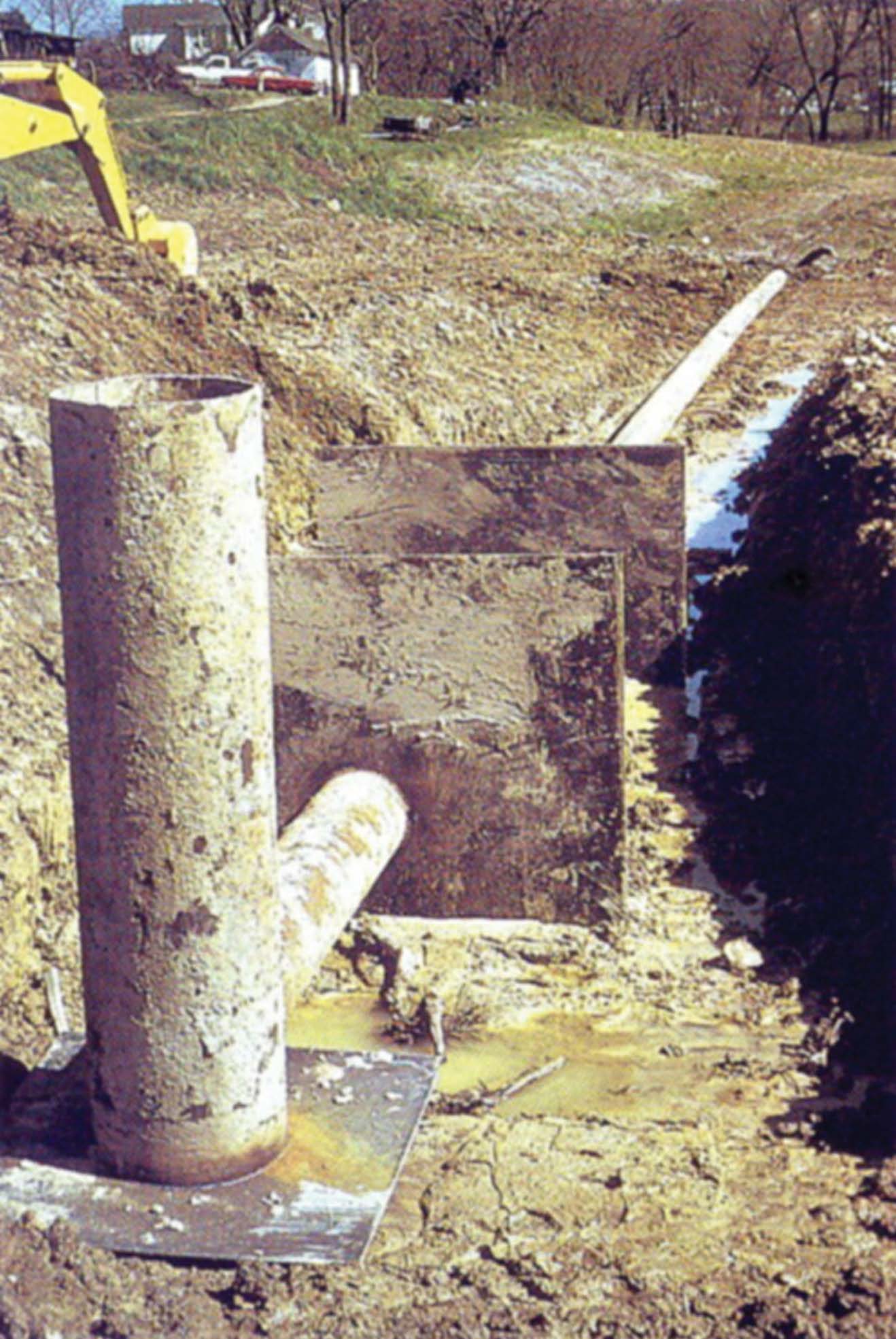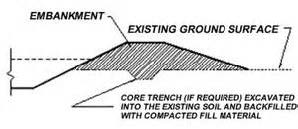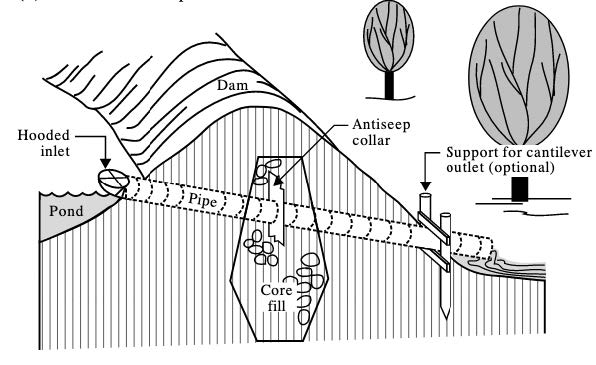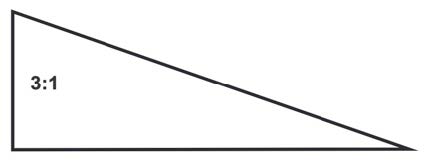Building a Pond
A pond is a major investment, so good planning is essential for avoiding mistakes. In addition to having a suitable site, a proper design and good construction methods are needed. This fact sheet aims to broaden the list of options and gives you the right questions to pursue with your construction engineer or pond builder.
Typically, Oklahoma ponds are watershed ponds: water runs off an area of land and is captured in a basin formed by constructing a dam (embankment) across a small “valley.” Livestock watering ponds are often constructed by excavation. Many sites are not suitable for building a pond: be prepared to be disappointed early, rather than very unhappy after building a pond that fails.
The expense of fixing a leaky pond is often cost-prohibitive. Pond liner-membranes can run $10,000 per acre and installing a liner of local clay may be similarly expensive, depending on the distance from where the soil is hauled. Applying bentonite clay to fix a leaky pond is hard work and it is not a guaranteed fix.
The largest single cost in building a pond is the amount of earthmoving required. Contractors typically charge by the cubic yard. Other costs include land clearing, site preparation, pipe, as well as seeding and mulching of newly exposed slopes to establish protective vegetative cover.
If fishing is an objective for your pond, it is best to build one that is at least 1/2 surface acre in size. From a fish management point of view, this is the minimum size needed. Smaller ponds are much more likely to suffer from poor fishing due to the difficulty of keeping bass and bluegill populations balanced. More on this in NREM-9209, “Improve Fishing in Your Pond.”
As plans are made for building a pond, it is helpful to understand the value of features to increase safety, lifespan and control. Imitating how others build their ponds may not be the best course: your pond-owning neighbors might have taken shortcuts when building their pond.
Figure 1. Take time to learn and consider the features of a well-designed pond. It will help you to make better choices and avoid costly mistakes when building a pond. Drawing not to scale. Image courtesy Alabama Cooperative Extension Service.
Earthwork Know-How
The typical prospective pond owners’ mind first turns to is selecting a good earthwork contractor. Too often, they stop there and do not seek a good engineer - more on this in the next section. Typically, a good contractor will have a track-record of success in building many ponds. The contractor should be willing to provide references so you can see their previous work. Be aware any general earthwork contractor can advertise for pond construction projects. A good pond construction contractor knows soils and proper soil compaction methods and will be conversant with the features discussed in this fact sheet. Specify up front everything you expect with the contractor so they can determine costs and get it all in the contract. Clear contract wording about methods and materials will avoid problems later (Figure 2).

Engineering Expertise
It is recommended to work with the Natural Resource Conservation Service (NRCS) (offices.sc.egov.usda.gov/locator/app) or a private civil engineering firm to obtain a site assessment and design. NRCS services are free. Engineers offer essential assessments and calculations that earthwork contractors often do not:
- Soil adequacy for intended uses.
- Sufficient storage volume with the least amount of earthwork.
- Safety and durability of structures.
- Hydrology.
- Adequate runoff to keep the pond full, taking hydrology and evaporation rates into account.
- Spillways large enough to handle maximum anticipated runoff events.
NRCS and private engineers also will be conversant with any permits that might be needed to comply with federal, state and local regulations, e.g.: wetland protection measures, the Clean Water Act and dam safety requirements. There is a possibility of cost-share funds through NRCS, but it is rare.
The Parts of a Pond
The watershed is the land area that drains to the pond. The pond depends upon it for adequate quantities of water. This runoff also is vulnerable to contamination. It is rare for the pond owner to own or control the entire watershed (Figure 3).
The basin is the area of land that will hold the pool of water. Efforts must be made to ensure it has minimal leakage.
The dam or embankment counteracts the enormous force of the water pushing against it and must be relatively impervious to leakage. Do not plant trees on the dam. Plant only grasses.
Overflows, or spillways in engineering vocabulary, allow the pond to handle heavy rainfall events by safely releasing excess water. There are other names for them such as drain, trickle tube or overflow. The proper names are principal spillway and auxiliary spillway (Figures 4 and 5).
Drains enable you to lower water levels. Siphons are a portable alternative. These are useful for:
- Emptying the pond when dam repairs or improvements to shorelines and the basin are needed.
- Springtime lowering of water level to thin stunted fish populations.
Drains require anti-seep collars and thorough tamping of soil around the pipe by “jumping jack” or similar equipment. Internal standpipes require a concrete counterbalance at their base to counteract buoyancy. (Figure 6)
Figure 3. Watershed size and cover type is a crucial consideration in evaluating a potential pond site and sizing overflow capacity. Well-vegetated natural watersheds are generally best. Photo courtesy Felicitas Corrales of Shidler, Oklahoma.
Figure 4. This pond image shows an internal standpipe primary spillway and an auxiliary spillway. Principal spillways are the first point at which a pond overflows. The auxiliary spillway has a higher elevation and is designed to handle overflows from heavy rainfall events. Image courtesy USDA - NRCS.
Figure 5. A trickle tube principal spillway is a common, low cost overflow for small ponds. Image courtesy USDA - NRCS.
The Right Soil for the Right Job
Soil must be assessed and used according to its best purpose (Figure 7):
- Topsoil stripped from the footprint of the future dam should be removed and stockpiled nearby to topdress the completed dam crown and faces.
- High clay content soil from the basin should be used to fill the core trench, in sequentially compacted layers (lifts).
- Adequate clay content soil from the basin should be used to construct the dam in sequentially compacted lifts, especially the front side, if it is in short supply. Soils with 30% or more clay content are generally considered acceptable. Consult with an engineer or NRCS about soil acceptability.
- Marginal clay content soil from the basin might be suitable for use in the backside of dam.
- Soil with rock, tree branches or high organic matter content should not be used in constructing the dam.

Site Problems
Take care with these potential issues:
- Too much exposure to wind. Shoreline or dam wave erosion is more likely if the prevalent wind direction is in line with the long axis of the pond.
- Too little exposure to wind. Ponds built in a hollow get no wind and are vulnerable to having their surface covered by duckweed and similar free-floating aquatic plants.
- Trees in the watershed may cause serious water quality problems for ponds. Leaves accumulate quickly in ponds and form a thick, black layer on the basin bottom that often releases nutrients that fuel excess pond plant growth. Oak leaves and their catkins (primitive flowers) stain and acidify the water.
- Ponds upslope from your pond are a source of possible undesirable fish species. These commonly move to lower ponds during heavy rains. This ruins the quality of fishing as they over reproduce and compete for the limited food available in the pond. Undesirable species include common carp, mudcats, and green sunfish. See NREM-9209, “Improve Fishing in Your Pond”.

Will It Hold Water?
To ensure the pond will hold water, spend time and money on the following steps. After-construction fixes for leaky basins and dams are expensive and may not work. Spend time and money upfront to avoid a non-functional pond.
- Avoid sites in which the basin soils lack sufficient clay content.
- Dig test holes on a 50- or 100-foot grid throughout the planned basin to sample soil conditions 1 foot to 2 feet below the planned basin elevation at each point. Hidden rock outcrops or pockets of gravel or sand can be a major expense to correct: know it upfront before committing to building on the site.
- Remove topsoil from the dam footprint, then excavate a core trench along the mid-line and fill it with well-compacted lifts of good clay content soil (Figure 8).
- Properly compact the soil in each lift (layer) as the dam is built. Use the right equipment and the right amount of moisture in the soil. It may be necessary to wait for soils to dry or to use a water truck to spray water as lifts are laid down (Figure 9).

Figure 9. A sheepsfoot roller can be used in compacting each lift during dam construction. Dozer tracks are a common alternative. Use of smooth rollers should be avoided. Image courtesy Alabama Cooperative Extension Service.
Design and Construction
There are numerous options and best practices to discuss with an engineer and contractor before work begins. Include all desired features and practices in the contract specifications. Have an agreed-upon cost for every item. Supervise the process of construction as closely as possible, especially the installation of any drain or spillway piping through the dam.
Dam Top Width and Face Slopes
A wider top width and gentler slope on the faces of the embankment increase the volume of earth that must be moved, but makes a stronger structure that is easier to maintain (Figures 10 and 11).
Shoreline Slope and Depth
Slopes of 3:1 below the waterline are usually advised (Figure 11). To prevent excessive growth of aquatic plants, minimize the areas of the basin that will be less than 3 1/2 feet in water depth. (Figure 12)
Peninsulas (Figure 13) can be considered when shoreline deepening is needed in excess of the amount of fill needed for the dam. They may offer better angling access and reduce wave damage to shorelines and dams in windy locations.
Islands might be constructed in larger ponds but only after careful calculation of the expense of earthmoving and compaction needed. Given the broadness of the base and slope needed, they take up too much volume to be considered in small ponds.
Protect bare soil on the newly constructed dam and basin slops against erosion:
- Always leave slopes rough by running tracked equipment straight up and down.
Figure 10. A dam with gently sloped faces and a broad top (top image) and another (bottom) with less favorable slopes and narrow top width, that is experiencing some wave erosion and the beginnings of shoulder damage. Image on left courtesy Alabama Cooperative Extension Service.
Figure 11. A generally advantageous slope for dam faces and shorelines is 3 feet of “run” for every 1 foot of “rise” (3:1).This reduces erosion potential, decreases the chances of child drownings and makes it possible to mow dam faces to eliminate young trees. Image courtesy Alabama Cooperative Extension Service.
Figure 12. Shoreline deepening is often recommended to reduce the potential for excessive growth of aquatic plants. Image courtesy Alabama Cooperative Extension Service.
Figure 13. Pushing up peninsulas by using a dozer to deepen shallow shoreline areas, is one strategy used to deepen shorelines in order to reduce weediness. Image courtesy Alabama Cooperative Extension Service.
Additional choices include:
- Mulching with straw.
- Seed or sprig grasses, if needed. Stockpiled topsoil from the dam “footprint” often has adequate seeds to vegetate the dam. NRCS personnel can advise on options for seeding and sprigging.
- Basin slopes also need vegetative cover. Any quick-growing, cheap seed is appropriate Cover on slopes below the waterline is only needed until the basin fills.
- Do not plant trees on the dam.
Erosion control is important: heavy rainfall can do major damage to unprotected slopes and sediment can greatly reduce basin volume.
Additional Options
Extra depth and storage capacity for drought periods can be considered. Possible downsides of an extra deep basin include:
- Greater risk of turnover fish kills.
- No extra fish production (fish production depends on the amount of sunshine).
- Increased cost of excavation and likelihood of leakage.
- The watershed’s runoff might not fill it - an engineering assessment is needed.
Fish attractors are commonly added to fishing ponds. These include:
- Constructing drop-offs and other irregularities in the basin.
- Adding felled trees left over from site clearing.
- Rock piles.
- Fabricated structures such as pallet and tire “pyramids,” “spiders” or pipe section bundles.
- Submerged peninsulas with a depth of 1 foot to 3.5 feet, may be considered if you want a good fishery, but the basin is lacking in areas less than 3 1/2 feet in water depth. The pond will require relatively stable water levels in order to support plant growth on these features. Submerged weedbeds produce food for fish and allow smaller fish to hide from bass. Note that yearly herbicide use might be needed to prevent spread of plants to other areas of the pond.
Do not install fish attractors in deeper areas. Areas more than 6 feet deep are likely to lack oxygen and not be used by fish.
Fish attractors should be few in number and located in easy-to-find locations, such as at the end of a dock, shoreline irregularity or be marked with a buoy.
Livestock watering features can be added in order to protect soft slopes against hoof damage and minimize amounts of animal waste contaminating water. More on this in NREM-2883, “Pond Management for Livestock, Fish and Wildlife.”
Dock pillars are best installed before the basin fills. ADA-compliant handicapped dock features can be considered. These include adequate width for wheelchairs, a smooth transition plate between land and dock and lowered railing sections to facilitate fishing while seated.
Avoid Poor Site Choices
- Watershed too small to fill pond basin.
- Soils in basin have inadequate clay content to hold water.
- Pollutant sources in watershed. Common ones include eroding land, dirt roads, illegal dumps, chemical fertilizers, animal manure and trash dumps.
Less common:
- Gypsum in the watershed or basin produces “gyp water” unsuited for fish. Most common in western Oklahoma.
- Dispersive and salt-affected soils lead to pond construction failures. When there is reason to suspect this problem, a crumb test should be done. Primarily in western and central Oklahoma.
- Iron pyrite (“Fool’s Gold”) in the watershed, when exposed to air and water produces runoff lethal to fish. It is reported from isolated locations in southeast and south-central Oklahoma plus Kiowa, Payne, Tulsa, Ottawa and Sequoyah counties.
- Flood-prone locations. Flat areas alongside streams and rivers are floodplains.
Avoid Poor Construction Practices
- Not removing topsoil from the dam “footprint.”
- No core trench to lock dam into an impervious layer of native soil.
- Unsuitable soils for the dam - inadequate clay content, wood, rock or debris.
- Poor soil compaction in the dam.
- Failure to recognize and seal areas of rock, gravel or sand in the basin to prevent major leakage.
- Failure to establish vegetation on dam, auxiliary spillway and basin slopes.
Understanding the pond-building process equips you to make better choices and avoid expensive mistakes. It also educates you to better understand how to monitor and carry out needed routine maintenance. Read more about this in NREM-9212, “Keep Your Pond in Good Condition.”
Related publications:
- NREM-9209, Improve Fishing in Your Pond
- CR-9205 Fingerlings for Pond Stocking
- NREM-2883, Pond Management for Livestock, Fish and Wildlife










